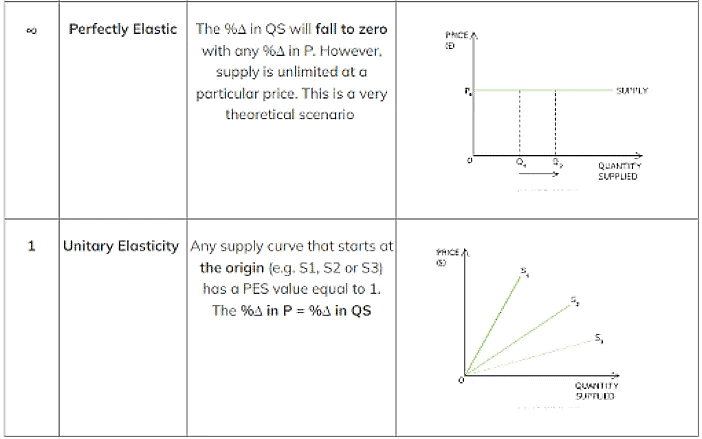Price elasticity of supply | Economics for Grade 12 PDF Download
The Definition & Calculation of PES
- The law of supply states that when there is an increase in price (ceteris paribus), producers will increase the quantity supplied & vice versa
- Economists are interested in how much the quantity supplied will increase
- Price elasticity of supply (PES) reveals how responsive the change in quantity supplied is to a change in price
- The responsiveness is different for different types of products
Calculation of PES
- PES can be calculated using the following formula

- To calculate a % change, use the following formula

Example: In recent months, the price of avocados has increased from £0.90 to £1.45. Bewdley Farm Shop in Wales have sought to maximise their profits by increasing the quantity supplied to market. They have been able to increase the supply of avocados from 110 units a week to 120 units a week. Calculate the PES of avocados & explain one reason for the value
Step 1: Calculate the % change in QS
Step 2: Calculate the % change in P
Step 3: Insert the above values in the PES formula
Step 4: Explain one reason for the value
The PES value of 0.15 indicates that avocados are very price inelastic in supply. Even with a significant increase in price, suppliers are unable to supply more likely due to the time it takes to grow additional avocados
Interpreting PES Values
The Values of PES Vary From 0 To Infinity (∞) & They Are Classified As Follows

The Determinants of PES
- Some products are more responsive to changes in prices than other products
- The factors that determine the responsiveness are called the determinants of PES & include:
- Mobility of the factors of production: if producers can quickly switch their resources between products, then the PES will be more elastic. For example, if prices of hiking boots increase & shoe manufacturers can switch resources from producing trainers to boots, then boots will be price elastic in supply
- Availability of raw materials: if raw materials are scarce then PES will be low (inelastic). If they are abundant, PES will be higher (elastic)
- Ability to store goods: if products can be easily stored then PES will be higher (elastic) as producers can quickly increase supply (for example, tinned food products). An inability to store products results in lower PES (inelastic)
- Spare capacity: if prices increase for a product & there is capacity to produce more in the factories that make those products, then supply will be elastic. If there is no spare capacity to increase production, then supply will be inelastic
- Time period: In the short run, producers may find it harder to respond to an increase in prices as it takes time to produce the product (e.g., avocados). However, in the long run they can change any of their factors of production so as to produce more
The Significance of PES for Stakeholders
If producers have a high PES (elastic) then they are able to respond to increases in price very quickly
- This is desirable as it means producers can increase revenues & profits if they can supply more
- Firms can increase their PES by:
- Creating more spare capacity on their production lines
- Maintaining larger inventories
- Using more modern technology
- If producers have a low PES (inelastic) then they are less able to respond to increases in price
- This shortage in supply will mean that prices continue to rise, possibly causing inflation in the economy
- Governments are very interested in the PES of key markets in the economy as they want to ensure that these markets can respond quickly to rising demand
- One e.g is the housing market. If the PES of housing is low (inelastic), property prices will become unaffordable with any increase in demand
- Another e.g. is the labour market. If the PES of labour is low (inelastic) then production costs of firms will rise quickly during periods of increasing demand when firms need to hire additional workers
|
23 videos|11 docs
|






















